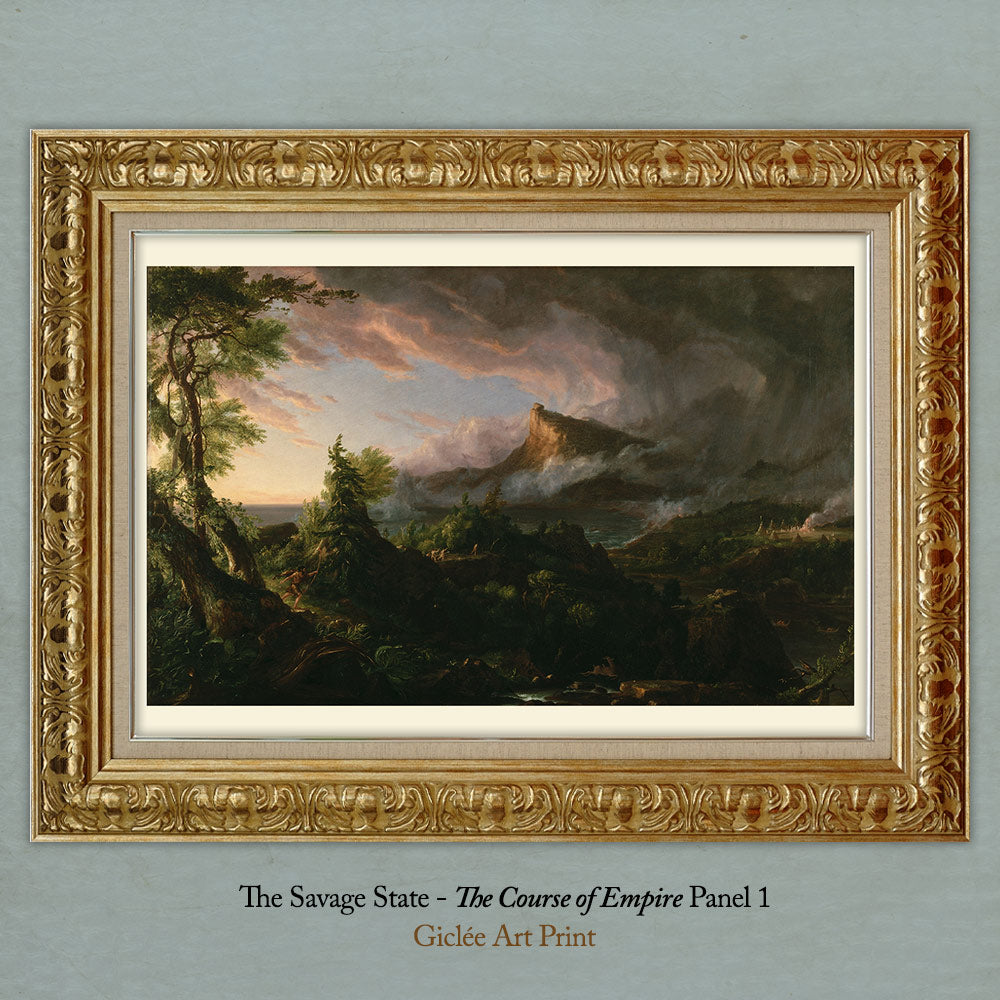








The Savage State Thomas Cole The Course of Empire Art Print
The first painting, The Savage State, shows the valley from the shore opposite the crag, in the dim light of a dawning stormy day. Clouds and mist shroud much of the distant landscape, hinting at the uncertain future. A hunter clad in skins hastens through the wilderness, pursuing a fleeing deer; canoes paddle up the river; on the far shore can be seen a clearing with a cluster of tipis around a fire, the nucleus of the city that is to be. The visual references are those of Native American life. This painting depicts the ideal state of the natural world. It is a healthy world, unchanged by humanity.
COLE'S DESCRIPTION:
No. 1., which may be called the ‘Savage State,' or ‘the Commencement of Empire,' represents a wild scene of rocks, mountains, woods, and a bay of the ocean. The sun is rising from the sea, and the stormy clouds of night are dissipating before his rays. On the farthest side of the bay rises a precipitous hill, crowned by a singular isolated rock, which, to the mariner, would ever be a striking landmark. As the same locality is represented in each picture of the series, this rock identifies it, although the observer's situation varies in the several pictures. The chase being the most characteristic occupation of savage life, in the foreground we see a man attired in skins, in pursuit of a deer, which, stricken by his arrow, is bounding down a water-course. On the rocks in the middle ground are to be seen savages, with dogs, in pursuit of deer. On the water below may be seen several canoes, and on the promontory beyond, are several huts, and a number of figures dancing round a fire. In this picture, we have the first rudiments of society. Men are banded together for mutual aid in the chase, etc. The useful arts have commenced in the construction of canoes, huts, and weapons. Two of the fine arts, music and poetry, have their germs, as we may suppose, in the singing which usually accompanies the dance of savages. The empire is asserted, although to a limited degree, over sea, land, and the animal kingdom. The season represented is Spring.
Museum-quality posters are made on thick and durable matte paper. Add a wonderful accent to your room and office with these posters that are sure to brighten any environment. (Frame not included.)
• Paper thickness: 10.3 mil
• Paper weight: 5.57 oz/y² (189 g/m²)
• Giclée printing quality
• Opacity: 94%
• ISO brightness: 104%

Collections: Father's Day, Handmade | Made by Hand by Maniacs, Home, Home and Living, Liberty Maniacs Wall Art | Posters and Prints, New Arrivals, Prints | Museum-Quality Art Prints, Wall Art | Prints, Canvases, Flags, Signs, and Metal Art
Type: Poster
Category: 19th century, allegorical, art, art print, civilization, classical paintings, cycle, landscape, liberty maniacs, oil painting, painting, poster, posters, savage, savage state, state, The Course of Empire, Thomas Cole, wall art, western civilization
















